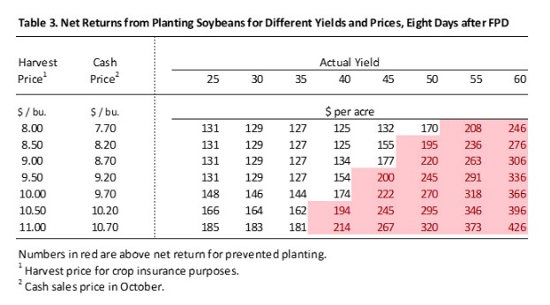By Carl Zulauf
Department of Agricultural, Environmental and Development Economics
Ohio State University
This article provides historical perspective on corn and soybean prevent plant acres. These acres are expected to be large, if not record large, in 2019; in part because corn and soybeans are large acreage crops in areas expected to have sizeable prevent plant acres. Prevent plant acres for corn and soybeans are compared to other crops. Average and highest shares are computed by state. Given widespread late planting of both crops in 2019, the highest share by state is applied to the March 30, 2019 Prospective Planting acres. Prevent plant acres at this level in 2019 would equal 6.6 million for corn and 4.3 million for soybeans. Given the historically unusual planting conditions in 2019, higher prevent plant acres are possible.
Data are from USDA, FSA (US Department of Agriculture, Farm Service Agency). It starts with the 2007 crop year. Another source of data is USDA, RMA (Risk Management Agency). Prevent plant acres vary somewhat by these two sources, in part because not all farms enroll in commodity farm programs and buy crop insurance. FSA data are used because it is a single, consistent set of data on prevent plant and planted plus failed acres.
Corn and Soybeans vs. Other Crops
For the 11 crops FSA has reported data for every year since 2006, corn accounts for over one-third and soybeans for one-fifth of prevent plant acres (see Figure 1). Along with wheat, they comprise 88% of the prevent plant acres for the 11 crops.
Prevent plant acres for corn, soybeans, and wheat reflect the large acres planted to those crops in the US. When prevent plant acres are compared to the sum of plant, failed, and prevent plant acres by crop, wheat ranks 3rd, corn 5th, and soybeans 8th out of the 11 crops (see Figure 2). Prevent plant share is less than 3% for all crops except extra-long staple cotton (14.0%) and rice (6.4%). Sugarcane effectively had no prevent plant acres.
Corn by State
Figure 3 presents the average and highest share of corn acres in prevent plant over the 2007-2018 crop years for the states that accounted for 95% of corn prospective planting acres in 2019. It is organized in descending order of highest share. Mississippi, Arkansas, and Louisiana are at the top of this ranking, with highest share of 33%, 29%, and 28%, all in 2015. North Dakota, South Dakota, and Missouri are among both the 11 largest acreage corn states in 2019 (Ohio and Missouri tied for 10th) and the first 10 states in Figure 3. Their highest prevent plant share are 27% (2011), 18% (2010), and 14% (2015), respectively. Nebraska is at the other end of the distribution, with a highest share of 1% (2015).

As Figure 3 illustrates, the difference between average and high share for a state can be large. The widespread, notable late planting of corn in 2019 is a reason to consider what happens if all states match their highest 2007-2018 share in 2019. Multiplying each state’s highest prevent plant share over 2007-2018 by its March 2019 prospective corn acres, then summing over all states; generates 6.6 million acres of prevent plant corn in 2019. This is approximately four times larger than the 1.7 million corn prevent plant acres if each state’s average share is used.
Soybeans by State
Among the states that accounted for 95% of soybean prospective planting acres in 2019, Missouri has the highest observed share of 19% (2015) (see Figure 4). North Dakota, South Dakota, and Kansas are also top 10 soybean states among the first 10 in Figure 4. Their highest shares are 11% (2011), 10% (2010), and 4% (2007), respectively. Nebraska and Iowa are at the other end of the distribution, with a highest share of 1%, both in 2015.
As with corn, the 2019 planting pace lags for soybeans in almost all states. If all states were to end up with prevent plant shares that match their 2007-2018 highest shares and using the state soybean acres in the 2019 Prospective Planting report; 4.3 million acres of soybeans would be in prevent plant. As with corn, this is approximately four times larger than the 1.0 million acres of soybean prevent plant if each state’s average share is used, again illustrating the wide difference between average and high shares.
Summary
- Prevalence of prevent plant vary by crop and state over the analysis period of 2007-2018. Prevent plant is thus not uniform across these two important economic and political dimensions.
- Corn, soybeans, and wheat account for 88% of prevent plant acres over the 2007-2019 crop years.
- The preceding point reflects the large acres planted to these three crops as their share of acres in prevent plant is in the middle of the 11 crops for which data are consistently available since 2006.
- Missouri, North Dakota, and South Dakota are among the 10 largest acreage corn and soybean states and the 10 largest corn and soybean prevent plant states measured as a share of acres.
- Given the notable lag in 2019 planting pace, a higher probability exits that corn and soybean prevent plant acres will be at the high end of the historical distribution for most states. Applying each state’s highest share of prevent plant acres over the 2007-2018 crop years to their intended acres for planting in 2019 generates 2019 prevent plant acres of 6.6 million for corn and 4.3 million for soybeans. These are roughly 4 times the prevent plant acres if the average shares are used. Given the historically unusual planting conditions in 2019, higher prevent plant acres are possible than projected by the highest historical share.